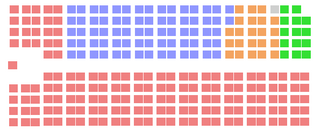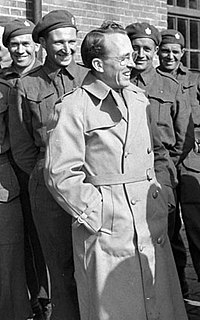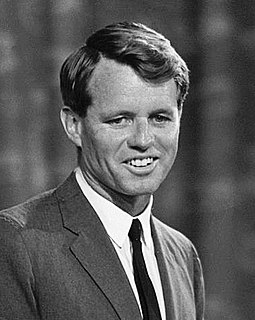The Canadian social credit movement is a Canadian political movement originally based on the Social Credit theory of Major C. H. Douglas. Its supporters were colloquially known as Socreds in English and créditistes in French. It gained popularity and its own political party in the 1930s, as a result of the Great Depression.

The Canadian federal election of 1972 was held on October 30, 1972, to elect members of the House of Commons of Canada of the 29th Parliament of Canada. It resulted in a slim victory for the governing Liberal Party, which won 109 seats, compared to 107 seats for the opposition Progressive Conservatives. A further 48 seats were won by other parties and independents. On election night, the results appeared to give 109 seats to the Tories, but once the counting had finished the next day, the final results gave the Liberals a minority government and left the New Democratic Party led by David Lewis holding the balance of power. See 29th Canadian parliament for a full list of MPs elected.

The Canadian federal election of 1984 was held on September 4 of that year to elect members of the House of Commons of Canada of the 33rd Parliament of Canada. The Progressive Conservative Party, led by Brian Mulroney, won the largest landslide majority government in Canadian history, while the Liberals suffered what at that time was the worst defeat for a governing party at the federal level. Only the Progressive Conservatives faced a larger defeat, when cut to two seats in 1993.

The Social Credit Party of Canada, colloquially known as the Socreds, was a conservative-populist political party in Canada that promoted social credit theories of monetary reform. It was the federal wing of the Canadian social credit movement.

The Canadian federal election of 1957 was held June 10, 1957, to select the 265 members of the House of Commons of Canada. In one of the great upsets in Canadian political history, the Progressive Conservative Party, led by John Diefenbaker, brought an end to 22 years of Liberal rule, as the Tories were able to form a minority government.
Historically in Quebec, Canada, there was a number of political parties that were part of the Canadian social credit movement. There were various parties at different times with different names at the provincial level, all broadly following the social credit philosophy; at various times they had varying degrees of affiliation with the Social Credit Party of Canada at the federal level.

The Canadian federal election of 1980 was held on February 18, 1980, to elect members of the House of Commons of Canada of the 32nd Parliament of Canada. It was called when the minority Progressive Conservative government led by Prime Minister Joe Clark was defeated in the Commons.

The Canadian federal election of 1979 was held on May 22, 1979, to elect members of the House of Commons of Canada of the 31st Parliament of Canada. It resulted in the defeat of the Liberal Party of Canada after 11 years in power under Prime Minister Pierre Trudeau. Joe Clark led the Progressive Conservative Party to power, but with only a minority of seats in the House of Commons. The Liberals, however, did beat the Progressive Conservatives in the overall popular vote by more than 400,000 votes.

The Canadian federal election of 1974 was held on July 8, 1974, to elect members of the House of Commons of Canada of the 30th Parliament of Canada. The governing Liberal Party was reelected, going from a minority to a majority government, and gave Prime Minister Pierre Trudeau his third term. The Progressive Conservatives, led by Robert Stanfield, did well in the Atlantic provinces, and in the West, but the Liberal support in Ontario and Quebec ensured a majority Liberal government.

The Canadian federal election of 1958 was the 24th general election in Canada's history. It was held to elect members of the House of Commons of Canada of the 24th Parliament of Canada on March 31, 1958, just nine months after the 23rd election. It transformed Prime Minister John Diefenbaker's minority into the largest majority government in Canadian history and the second largest percentage of the popular vote. Although the Tories would surpass their 1958-seat total in the 1984 election, the 1958 result remains unmatched both in terms of percentage of seats (78.5%) and the size of the Government majority over all opposition parties. Voter turnout was 79.4%.

The Canadian federal election of 1962 was held on June 18, 1962 to elect members of the House of Commons of Canada of the 25th Parliament of Canada. When the election was called, Progressive Conservative (PC) Prime Minister John Diefenbaker had governed for four years with the then-largest majority in the House of Commons in Canadian history.

The Canadian federal election of 1963 was held on April 8 to elect members of the House of Commons of Canada of the 26th Parliament of Canada. It resulted in the defeat of the minority Progressive Conservative (Tory) government of Prime Minister John Diefenbaker. For Social Credit, despite getting their highest ever share of the vote, the party lost 6 seats compared to its high-water mark in 1962.

The Canadian federal election of 1965 was held on November 8 to elect members of the House of Commons of Canada of the 27th Parliament of Canada. The Liberal Party of Prime Minister Lester B. Pearson was re-elected with a larger number of seats in the House. Although the Liberals lost a small share of the popular vote, they were able to win more seats, but fell just short of having a majority.
This is a seat by seat list of candidates in the 2004 Canadian election.
In 1963, the Quebec wing of the Social Credit Party of Canada split off from the national party as the Ralliement des créditistes. The split had its roots in a long-standing dispute between the de facto leader of the Ralliement, Réal Caouette, and the party’s national leader, Robert N. Thompson. At the party’s 1960 leadership convention, held two years after the party lost all of its seats in the House of Commons of Canada, Thompson defeated Caouette for the leadership. The party returned to Parliament in the 1962 federal election, but all but four of its 29 MPs came from Quebec. Under the circumstances, Thompson was all but forced to name Caouette as deputy leader of the party. The relationship was strained, however, and the strain was exacerbated when the party failed to make any gains in its old heartland of the Prairies in the 1963 federal election. Only Thompson and three others were elected outside of Quebec, while 20 Socreds were elected in Quebec. The two factions of the party were not re-united until October 1971.
The New Democratic Party is a social democratic federal political party in Canada. The party was founded in 1961 out of the merger of the Co-operative Commonwealth Federation (CCF) with the Canadian Labour Congress (CLC). The party sits to the left of the Liberal Party of Canada within the Canadian political spectrum. The leader of the federal NDP is Jagmeet Singh, who won the 2017 leadership election.
This article covers the history of the New Democratic Party of Canada.
The Canadian social credit movement first contested the 1935 federal election in order to capitalize from the Alberta Social Credit League's surprise victory in Alberta's August 1935 provincial election. Social Credit supporters ran as the Western Social Credit League and John Horne Blackmore was appointed the movement's parliamentary leader following the election although Alberta Premier William Aberhart was generally regarded as the unofficial national leader of the movement.




















